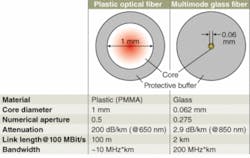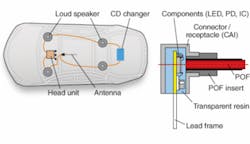BERND LUECKE
The need for easy and affordable short-range high-speed communication is ever growing. While the method of choice is wireless communication, wireless falls short when high-quality service is needed or when the application is sensitive to electro-magnetic interference (EMI). Plastic optical fiber (POF) is perfectly suited to these applications. While many people know about optical glass fibers, the less-expensive POF counterpart is less well known despite its routine use in the engines of high-speed trains, in POF-based multimedia entertainment in premium cars, or in digital audio links in home theaters.
In the 1980s POF links were adopted for use in low-speed industrial-control applications in which electrical isolation of the control link was required. Examples include high-power electric motors for electric locomotives or for generators in wind turbines—markets that have grown rapidly over the last few years. And in the 1990s, POF links for digital audio were implemented in state-of-the-art audio devices, but with some limitations. In 2001, the first car with a POF-based “infotainment” system went on the road. Millions followed over the next few years making POF networks in cars a success story.
POF technology
Apart from being made of low-cost materials, the unique advantages of POF come from the large diameter of the light-guiding core. A 1 mm core diameter enables easy and mechanically robust coupling of light sources into the fiber; in contrast to glass fibers, this coupling can be done using cost-efficient passive alignment with relaxed tolerances. Such robust coupling makes it possible for service personnel in an automotive repair shop or even home users to handle and install the fibers—a task that would be difficult with glass fiber connectors. Although glass fibers with a 1 mm diameter are possible, they would be too stiff for most applications. The inherent elasticity of POF makes it intrinsically insensitive to mechanical shock and resistant to cracks (see Fig. 1).
The only clear disadvantage of POF is its low bandwidth, which limits the data rate it can carry to about 200 Mbit/s for a 50 m link. However, an improved version of simple step-index POF is graded-index POF. This fiber overcomes the bandwidth limitation, but has the disadvantage of higher cost and limited temperature performance. Despite these drawbacks, POF is the first choice when the link length is short (maximum 100 m), when the system has to be rugged, and when the required data rate is less than 500 Mbit/s.
The fiber is only one element of a POF network; the ruggedness of the individual fibers must also be matched by the network’s sending and receiving elements. The transmitters and receivers normally use reliable red 650 nm light-emitting diodes (LEDs) and large-area photodiodes, respectively. Green and blue LED sources can also be used, enabling even lower insertion losses, but these LEDs require power-supply voltages of more than the usual 3.3 V, making them less attractive in combination with state-of-the-art driver integrated circuits.
The intrinsic LED speed limit for direct binary modulation was below 100 Mbit/s for some time, but was extended a few years ago up to 250 Mbit/s. This speed works with normal LED structures making the long-hyped and complex resonant-cavity LEDs (RCLEDs) a second choice. To further improve the link speed, lasers can be used as sources. But because there are currently no inexpensive 650 nm temperature-stable commercial-grade lasers available, other means are necessary to improve the link speed of plastic fibers. One solution is to use optimized bandwidth-utilization techniques very similar to those used for digital subscriber line (DSL) phone technology. With these techniques, the speed limit has been further extended to 1 Gbit/s and beyond despite the use of bandwidth-limited LEDs.1
Industrial drives and generators
Industrial electrical drives and generators are ubiquitous systems used in numerous industrial applications like locomotives, ship engines, rolling mills, and water and wind turbines. Their purpose is the conversion of mechanical movement to electrical power or vice versa; power electronics such as rectifiers and inverters are needed to accomplish this task.
In such high-power transformation systems, galvanic insulation becomes very important to actively and reliably control the switching of the high voltages involved. Whenever voltage levels above several kilovolts must be controlled, fiber-optic links are the best method to realize this insulation across a control link. Because modern wind turbines are getting larger and larger to create as much power as possible, the voltages come into a range that is best addressed with optical fiber links.2 Because POF is low cost and rugged, it is preferred over glass fiber (see Fig. 2).Automotive
The dominant use of POF in automobiles is connected to the Media Oriented System Transport (MOST) standard, which was developed as a POF-based infotainment system connecting audio devices including telephone systems, head units, DVD changers, and navigation units in a single-fiber unidirectional optical ring.3 This architecture uses less fiber and transceivers than a two-fiber bidirectional structure and is thus much more cost-effective (see Fig. 3). The first car with a POF-based 25 Mbit/s MOST infotainment system was a 7-series BMW. Many more systems have followed, including Mercedes, Audi, Volvo, and most recently, Hyundai.Apart from being lightweight, the big advantage of an optical medium in a car is that it neither emits, nor is it affected by, electromagnetic radiation—a tremendous feat considering the “Faraday cage” environment inside an automobile and the many noisy electronic devices such as electronic motor controls, power windows, and windshield wipers. By using optical links, automotive engineers planning new multimedia technologies can be sure that the system will eventually work inside a car regardless of all the electrical systems. In contrast, electrical links require lengthy and comprehensive testing in a real-world environment that correspondingly lengthens the development process for a car by several months.
Critics of automotive POF systems cite the limited maximum temperature of 95°C, the required controlling of the fiber bending radius, and the higher handling and connector cost. Some car manufacturers have decided against the use of POF—Toyota, for example, is starting to implement an electrical version of MOST at 50 Mbit/s. Only time will tell if this approach is competitive with the optical solution.
Because the speed of the MOST25 standard is limited to 25 Mbit/s and is insufficient for high-quality video streaming or camera-based driver assistance systems, next-generation multimedia systems for cars are currently in development. A promising candidate for these applications is the MOST150 standard targeting a speed of 150 Mbit/s. Designed as a backward-compatible high-speed successor of MOST25, the MOST150 standard will include POF transceivers with a new package design that integrates transmitter and receiver in a single device with two fiber ports, allowing cost-effective soldering of the transceivers and easy direct-fiber coupling. MOST150 even allows tunneling of Ethernet packages. It is also possible to implement the well-known Ethernet protocol using POF as the medium and offering direct compatibility with existing Ethernet communications systems, as well as a protocol that could be—in terms of the software—easily upgraded from 100 Mbit/s to 1 Gbit/s speeds. Regardless of which system wins the race for the next-generation automotive network, it is very likely that the medium will be POF.
New applications
Among the emerging applications for POF-based systems, home networking and especially video streaming for Internet-protocol television (IPTV) play well to the technical advantages of POF. Because POF can be cut with a cheap Guillotine-like cutting tool and directly inserted in a locking clamp that has the optical transceiver inside (cut and plug), extremely low-cost devices are possible. Another advantage is that the fiber can be made six times thinner than a standard electrical Ethernet cable while the quality of service is very high, allowing permanent 100 Mbit/s connections that are sufficient for three simultaneous high-definition video streams. In fact, consumer products offering 100 Mbit/s fast Ethernet POF links are already on the market.4
Another promising application is drive-by-wire or fly-by-wire. Safety-critical functions like braking or chassis suspension control in cars, or steering-gear control in airplanes are increasingly being implemented digitally. And especially in next-generation airplanes, in which the fuselage is made of composite materials, electrical wires are problematic because of EMI issues and lightning protection.
Plastic fibers can also solve problems in mobile devices such as laptop computers. With displays moving to higher and higher resolution, the links between the main board and the display must be faster. At the same time the display should be very flexible for repeated opening and closing, as well as for three-dimensional movements and twisting. This requires a reliable and flexible high-speed link—a problem that is currently solved by complex and expensive parallel microcoaxial copper links. Here, POF can be a low-cost solution offering not only a flexible and reliable high-speed link, but also one that is completely noncritical in terms of EMI.
REFERENCES
1. S. Randel et al., Proc. ECOC 2007, Berlin, Germany (2007).
2. Avago Whitepaper, “Industrial Fiber Optic Products for Wind Turbine and Wind Farm Applications,” www.avagotech.com/assets/downloadDocument.do?id=28267
4. gigaset.siemens.com/shc/0,1935,hq_en_0_129657_rArNrNrNrN,00.html
Bernd Luecke is marketing manager at Avago Technologies Fiber, Wernerwerkstrasse 2, 93049 Regensburg, Germany; e-mail: [email protected]; www.avagotech.com.


